General Information
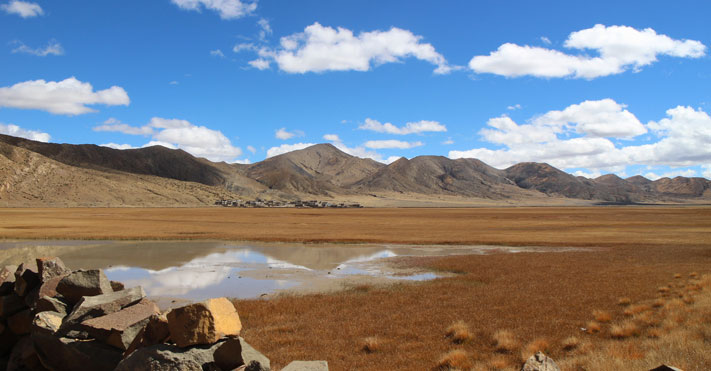
Tibet is a plateau region in Asia, north-east of the Himalayas, located on the Qinghai-Tibet Plateau at the southwesternmost tip of China with 4,000 meters above sea level at an average. Tibet is known as the Roof of the World because there are over 50 peaks more than 7,000 meters above sea level. Tibet is the traditional homeland of the Tibetan people. In the seventh century, King of Songtsen Gampo united Tibet and founded the Turpan Regime. Tibet is charming for its beautiful and spectacular landscape, the unique folklore, and the brilliant culture, which have drawn numerous visitors from around the world. Below is more information about Tibet to help you acknowledge of this highest region on earth.
Geography
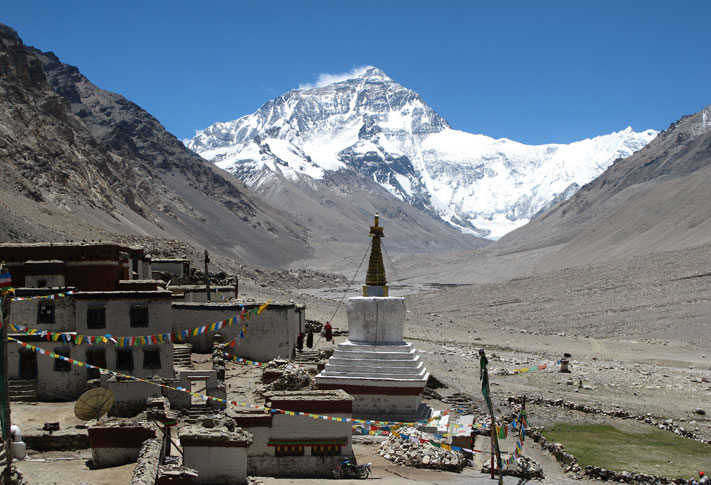 Rongbuk Monastery at Everest Base Camp
Rongbuk Monastery at Everest Base Camp
Tibet situated in the southwest of China covering area of 1.2 million square meters. It is adjoined with Xinjiang and Qinghai to the north, Sichuan to the east, and Yunnan to the southeast, bordered to India, Nepal, Burma, Sikkim and Bhutan to the south and Kashmir to the southwest.
Tibet has a very complex topography and falls into three geographic parts: the northern Tibet Plateau in the west that lies between the Kunlun, the Tanggula, the Gandise and the Nyanqin Tangula ranges, covering two-thirds of the total area of Tibet; the river valleys in the southern part of Tibet which lie between the Gangdise and the Himalayas; the eastern part of Tibet is made up mostly of canyons, and the entire area is marked by a gradual decline in altitude interrupted by small mountain systems called the Hengduan mountain ranges.
There are some of the world’s tallest mountains standing in Tibet, the renown one is Mount Everest at 8,848 metres, the highest mountain on earth. Several major rivers have their source in the Tibetan Plateau, include Yangtze, Indus River, Mekong, Ganges, and the Yarlung Tsangpo River (Brahmaputra River). The Yarlung Tsangpo Grand Canyon, along the Yarlung Tsangpo River, is the deepest canyons in the world. Numerous high altitude lakes scattered in vast Tibet, most of them are salt water lakes. The representatives are Lake Manasarovar, Namtso Lake, Yamdrok Lake, Siling Tso, Lhamo La-tso, Bangong Tso ect
Climate
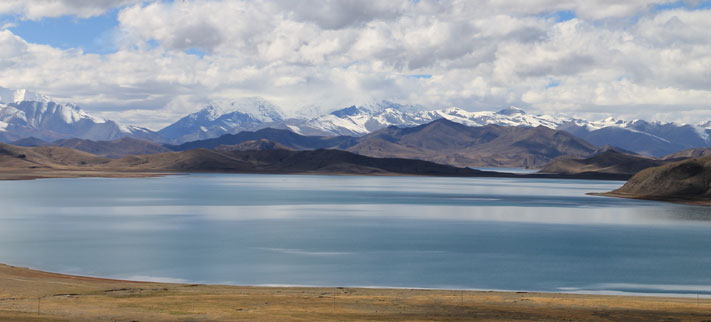 Yamdrok Yumtso lake
Yamdrok Yumtso lake
Generally speaking, the air here is thin, lower pressure with low oxygen. The sun is strong and sunshine time is long. Temperature here is obviously different in day time and night. The climate in Tibet varies greatly in parts. Influenced by the humid air current from the Indian Ocean, the southeastern Tibet is mild and temperate. In the north and west Tibet, it has a typical continental climate with the average temperature below 0℃, the freezing season lasts half of the year. In Lhasa and the central part of Tibet, the climate is temperate and nice for travelling that is neither too cold in winter nor too warm in summer, especially from March to October, the best season for travelling in Tibet. The whole year in Tibet can be divided into two different seasons; the dry season (the dry season usually is from October to April) and the raining season from May and September.
Population
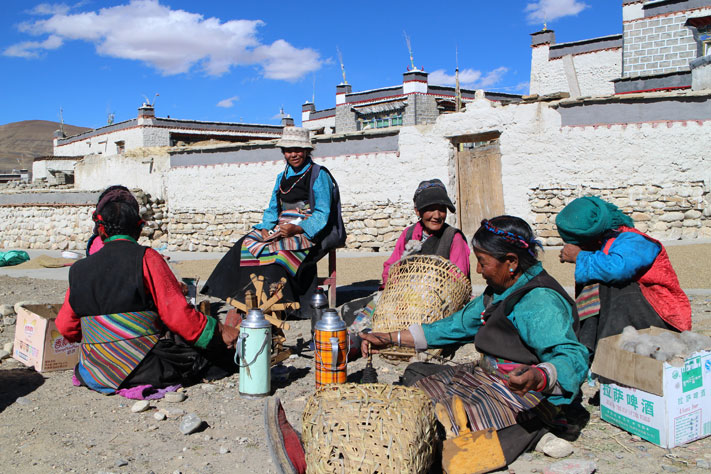 Tibetans in centra Tibet
Tibetans in centra Tibet
The population of the Tibetan nationality accounts for over 90% of the total region. With diversity in terms of distribution, most people live in rural areas, and fewer in cities and towns. Affected by nature, geographic conditions and climate, 85% of the population in Tibet is distributed mainly in the southeast of Tibet covering Lhasa, Shigatse, Lhoka, Nyingchi and Chamdo, while only few people inhabit in the northern part Nachu and west part Ngari because of its harsh climate, where the land areas make up 58% of the whole Tibet, but the population account only 15% of the totality.
Tibet is an area where Tibetans live as major ethnic group; there are other ethnic nationalities such as Moslems, Lopas, Sherpas, and Tengpas who haven’t been distinguished as individual groups owing to their little population which is only about 2000 people.
Religion
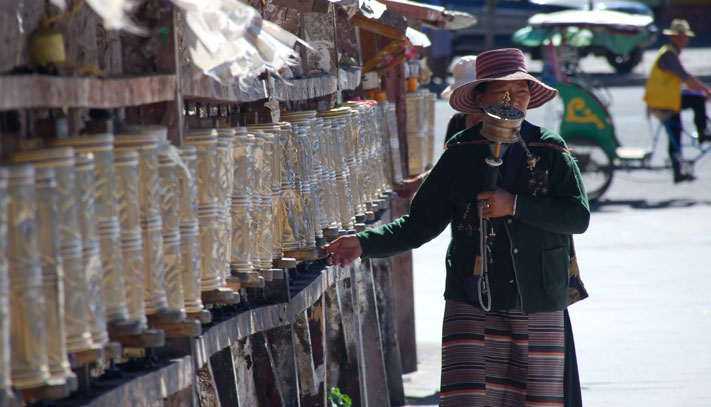 A lady with prayer wheel in Lhasa
A lady with prayer wheel in Lhasa
Nearly all Tibetans follow Tibetan Buddhism, known as Lamaism, with the exception of approximately 2,000 followers of Islam and about 600 Roman Catholics. In its infancy, Tibetan Buddhism was greatly influenced by Indian Buddhism, but after years of evolution, Tibetan Buddhism developed its own distinctive qualities and practices. A well-known example is the belief that there is a living Buddha, who is the reincarnation of the first, a belief not held by Chinese Buddhists.
Tibetan Calendar
The Tibetan calendar, an almanac created by Tibetans has a history of 1300 years. The Tibetan calendar is mixed with the calendar of Yin and Yang, which is divided one year into four seasons: winter, spring, summer and autumn. The first month of the twelve is Yin (correspondent to March). The big months alternate with the small months. After every two or three years an intercalary month is added to regulate the seasons. It is quite different between the intercalary time and agricultural calendar. Due to being influenced by the Han calendar, the heavenly stems have always designed the Tibetan calendar and Earthly branches as annuals. Its difference is used the Five Elements to go instead of ten Heavenly stems. Jia yi (the first and the second of the ten heavenly stems) is symbolized of wood. Bing ding (the third and the fourth) is symbolized of fire. Mao ji (the fifth and the sixth) is symbolized of earth. Geng xin (the seventh and the eighth) is symbolized of gold. Ren kui (the ninth and the tenth) is symbolized of water. Any of the twelve animals goes instead of the twelve Earthly branches such as Zhi is symbolized of the rat. Chou is symbolized of oxen and so on. For instance, Jia zhi year in lunar calendar is called the year of fire tiger in Tibetan calendar. A cycle of sixty years is called ‘Rabchung’ in Tibetan calendar, which is similar in content to ‘the sixty year-old’ in the hinterland of China.
Tibetan Medicine
Tibetan medicine has a history of 2000 years. According to the historical record, several centuries ago, during the lengthy course of fighting the nature and disease by Tibetans, some part of fauna and flora and mineral products are found to deliver people from plains. They thought, ‘poison could be used as an antidote to poison’. Then they developed the medicinal knowledge of stanching bleeding by using butter.
With the people’s recognition to nature and productive development, Tibetans accumulated rich experience for Tibetan medicine. When then Han Princess Wencheng and Jincheng came to Tibet in marriage, they brought a large number of books on traditional Chinese medicine and medical practitioners and promoted the Tibetan medical development. Among them, the most famous Tibetan medical practitioner in 8th century was Yuthok Nyinngma Yonten Gonpo systematically complied the Four Medical Tantras as the result of colored wall charts which are convenient for people to study and understand. It is not only the initiative in our country but also being rare in the world.
Tibetan medicine has the astonishing description in the embryology of humanity and the formation of human body in early times as well as many remarkable features of curative effects on medical treatment. For instance, the ready-made medicines to cure hemiplegia with seventy medical peal herbs and hypertension with the red coral are all testified by medicinal experiments as good dosages. Specially, they have very remarkable curative effects on curing leprosy and cancer.
Tibetan Art
Painting and sculpture are two of the most representative items in Tibetan art. Tibetan painting is originated from ancient rock paintings, which mainly depict animals such as deer, yak, sheep, horse, and hunting activities. During the Tubo period, the art of painting was flourishing. Specially, after Buddhism was introduced to Tibet, the religious paintings had been further developed. The art of Buddhism had been kept and inherited the traditional technique of Tibetan nationality. They have paid more stress on absorbing the art essence of Indian, Nepal and Han national cultures with unique splendor and style. The expressive from in Tibetan painting mainly is in stone inscription, fresco, Thangka, ect.
The fresco has a grand scale of capacity, which deals with a wide range of religion, politics, history, economy, culture, Tibetan medicine and social life, ect. It all encompasses varied contents from Buddhist inscription, religious doctrine, mythology, legend, historical story, living scene to the landscapes of mountain and river or plume with birds and flower and picture’s decoration ect.
The drawing style of the frescos is so particular that its colors are inclined too cold, dark. The colors chiefly consist of deep blue, purple, grey, earthly yellow and white. Mainly lines and traces in white depict it. The coloring is applied to be simply, bold or leave empty and blank. The fresco is not only provided with artistic effects and unified with the palace’s harmonized atmosphere, but also the artistic image of exaggeration, the vivid and vigorous expression or the strongly unsophisticated flavor of decoration.
Thangka is another traditional art of painting next to mural painting, which is a roll of painting with decoration in colored ribbons. It has a clear national character and is strongly in religious colors and in unique art style. The theme of Thangka has drawn from the social history of Tibet and the historical and genre paintings for living customs and also reflected the scientific range of astronomy, calendar, and Tibetan medicine and medical treatment. The Thangka has remarkable characteristic of making a painting according to history or explaining history on painting. But the major subject of Thangka in Tibet is religion. Tibetan Thangkas over 80% are Buddha’s images, preachings, monasteries, religious figures and stories. Thangkas, which describe Tibetan history and natural science, are all painted strongly in religious color. Tibetan folk art in sculpture can be divided into several styles such as stone carving, copper carving, clay sculpture, animal bone sculpture and butter sculprure of which stone caring is most popular.
Major Festivals
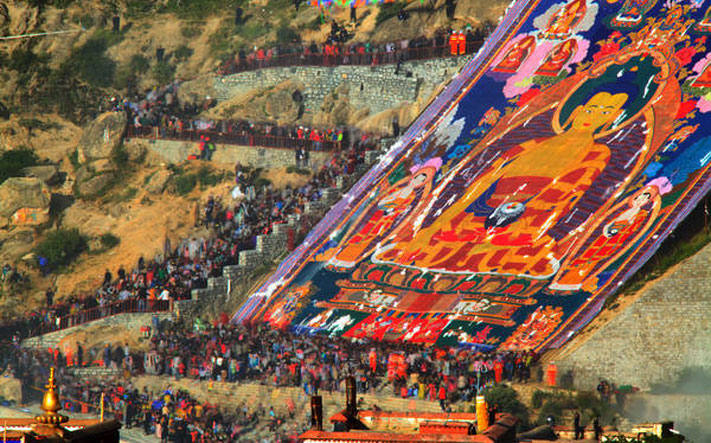 Shoton Festival in Tibet
Shoton Festival in Tibet
There are many festivals in Tibet. From the beginning to the end of the whole year, there are more than twenty or thirty big and small festivals. These days are great occasions for the reunion of families and friends or relatives as well as the social communications of men and women with singing and dancing for their enjoyment. It is also a good opportunity for people to show their artistry and performing talents. The traditional festivals are of long standing, many festivals have evolved into purely religious events. With time is passing by, its proportion of the festivals gradually tend to be more folky any entertained.
The Tibetan New Year
The first day of the first month in Tibetan calendar is the Tibetan New Year that is in February or March according to the Gregorian calendar. This is an important festival of the year for Tibetans. At the beginning of the twelveth month in Tibetan calendar, Tibetans start to prepare the holiday gifts including the ‘auspicious bushel’ which is filled with barley flour mixed with butter and fried wheat and ginseng. On the top of the barley flour is inserted the highland barley ears, the cockscomb and the colored flower plat made of butter. Early on the New Year day’s morning, Tibetans, men and women, dressed in their holiday best carry it in hand to exchange New Year’s greetings and the good wishes to each other, saying ‘Tashi Delek’ which means auspicious or luck. After these few days, they also go to the monasteries nearby to worship Buddha, or sing and dance on the streets, or go to visit their relatives and friends for drinking to their heart’s content to enjoy the New Year together. Everyone is intoxicated with spirit of the festival.
The Shoton Festival
On the First of the Seventh month, or August in Gregorian calendar, traditionally, after the monks are required to remain sequestered in their monasteries for the ascetic practice of Buddhism, people from their families prepared sour milk for them to drink with dancing following in their period of confinement. Shoton means ‘Yogurt Festival’. In the early 17th century, the Shoton Festival became a joint performance with the Tibetan operas. Tibetan artists with different schools from all over Tibet came to gather in Norbulingka to have a performing competition, which lasted for several days. During this period, the Drepung Monastery would hold a large portrait of Buddha displaying ceremony.
The Saga Dawa Festival
It is called ‘the festival to free captive animals’ in local custom. Through the whole fourth month, monks don’t eat meat and don’t commit slaughter. They only concentrate themselves on turning prayer wheels and reciting Buddha’s scriptures. It is said that on the 1st of the fourth month is the day that Sakyamuni was born, became enlightened and achieved nirvara On this day every year, people in their holiday best, singing and dancing, go into parks for their dinner party.
The Wongkor (Bumper Harvest Festival)
It is an occasion that Tibetans long for a bumper harvest. When the important moment comes, people in their colorful clothes uphold colored flags with good wishes. They make a pagoda of harvest with the ceremonial scarves twining round the highland barley and the wheat ears, beating drums and gongs, singing in their odes and walk around the fields in prayers for a bumper harvest, and then followed by a horse race. The autumn harvest starts as soon as the festival is over.
Butter Lamp Festival
The Butter Lamp Festival is celebrated on the 15th day of the first month every year. Monks from monasteries and local artists make various-shaped butter flowers with colored butter in pyramids in front Jokhang Monastery. In the evening, after the butter lamps are lit, their lights look just like stars dazzling in the sky. The pyramids made of butter include of immortals, animals, flying birds, beasts, and flowers.
Bathing Festival
In the 7th month in Tibetan calendar or in September in Gregorian calendar is the period, which the Venus appears only for seven nights in one year. Tibetan people think the water is specially holy and clean during this week. They believe that the dirt can be washed off, illness can be cured and their health can be improved. During the week, people all go to riverbanks for bathing, washing their clothes and playing at their pleasure.
Horserace in Gyantse
In memory of the local King Rapten Kunsand the festival falls on the 10th – 27th of fourth month in Tibetan calendar. During the festival many activities such as horse race and archery, Tibetan opera, singing and dancing as well as barter trade are held (it was originated in 1408).
Horse Racing Festival in Nachu
This festival falls on 10th August, the golden time of grassland. Thousands of nomads ride to Nachu town from all directions with different kinds of local products. A temporary tent city appears to the north of Nachu town, the festival includes programs: horse race, archery, sports, the world-famous Gesar Epic ballad recitation and so son.
Horse Racing Festival in Damxung
Being a tradition on Changthang grassland, Damxung horse race is held in every August. During the festival, tourists can appreciate traditional programs such as horse race, archery and horsemanship. Besides stone lifting, tug-of-war and other activities are performed. The large-scale goods exchange is held, too.

